Letter Format 书信格式
书信英文作文格式
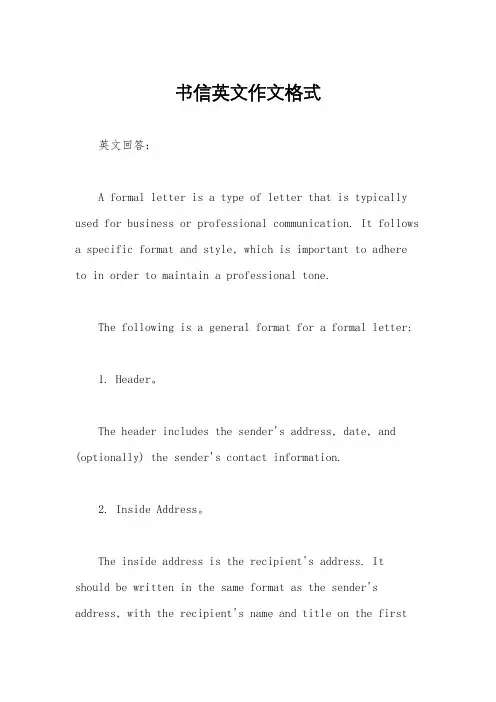
书信英文作文格式英文回答:A formal letter is a type of letter that is typically used for business or professional communication. It follows a specific format and style, which is important to adhere to in order to maintain a professional tone.The following is a general format for a formal letter:1. Header。
The header includes the sender's address, date, and (optionally) the sender's contact information.2. Inside Address。
The inside address is the recipient's address. It should be written in the same format as the sender's address, with the recipient's name and title on the firstline, followed by the company or organization name (if applicable), and then the street address, city, state, and zip code.3. Salutation。
The salutation is a formal greeting, such as "Dear Mr./Ms. Last Name" or "To Whom It May Concern."4. Body。
书信类的英文作文格式
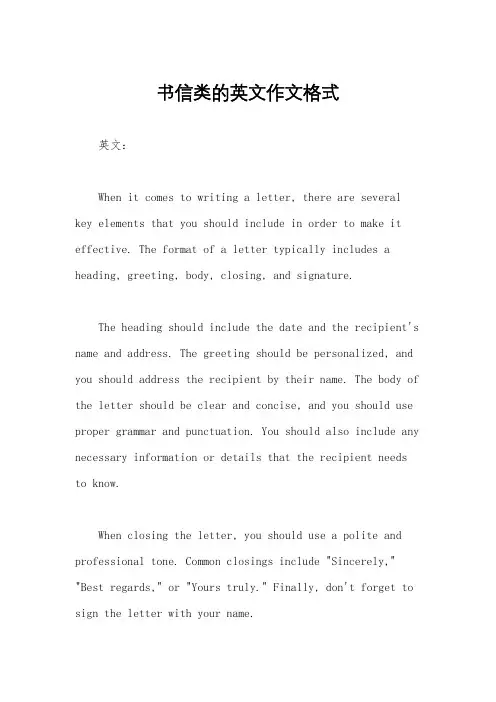
书信类的英文作文格式英文:When it comes to writing a letter, there are several key elements that you should include in order to make it effective. The format of a letter typically includes a heading, greeting, body, closing, and signature.The heading should include the date and the recipient's name and address. The greeting should be personalized, and you should address the recipient by their name. The body of the letter should be clear and concise, and you should use proper grammar and punctuation. You should also include any necessary information or details that the recipient needs to know.When closing the letter, you should use a polite and professional tone. Common closings include "Sincerely," "Best regards," or "Yours truly." Finally, don't forget to sign the letter with your name.中文:写信时,要想让它有效,就需要包含几个关键要素。
英语书信作文格式模板

英语书信作文格式模板英文回答:Letter Writing Format。
Format:1. Sender's Address: Your address in the top right-hand corner.2. Date: The date of writing, below the sender's address.3. Recipient's Address: The recipient's address below the date.4. Salutation: A formal greeting, e.g., "Dear Mr./Ms. [Recipient's Name]."5. Body: The main content of the letter, divided intoparagraphs. Start each paragraph with an indentation.6. Closing: A formal sign-off phrase, e.g., "Sincerely," "Best regards," etc.7. Signature: Your handwritten signature below the closing.Example:```。
123 Main Street。
Anytown, CA 12345。
March 8, 2023。
Mr. John Smith。
456 Elm Street。
Anytown, CA 67890。
Dear Mr. Smith,。
[Body of the letter]Sincerely,。
[Your Signature]```。
Tips:Use clear and concise language.Proofread carefully before sending.Be respectful and professional in your tone. Use a standard font and font size.Leave appropriate margins.中文回答:书信格式模板。
私人书信作文模板格式
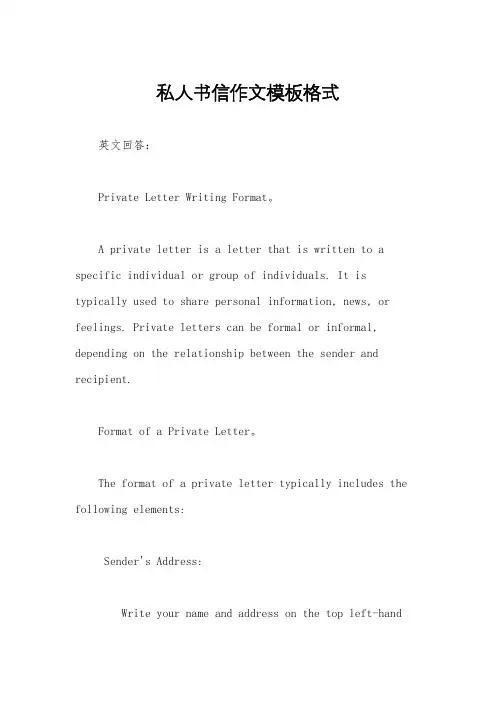
私人书信作文模板格式英文回答:Private Letter Writing Format。
A private letter is a letter that is written to a specific individual or group of individuals. It is typically used to share personal information, news, or feelings. Private letters can be formal or informal, depending on the relationship between the sender and recipient.Format of a Private Letter。
The format of a private letter typically includes the following elements:Sender's Address:Write your name and address on the top left-handcorner of the page.If you are writing from a business address, include the business name and address instead.Date:Write the date the letter was written on the same line as your address, but on the right-hand side of the page.Salutation:The salutation is the greeting that you use to address the recipient.For formal letters, use "Dear" followed by the recipient's title and last name (e.g., "Dear Mr. Smith").For informal letters, you can use "Hi" or "Hello" followed by the recipient's first name (e.g., "Hi John").Body of the Letter:The body of the letter is where you write the main content of your letter.Use clear and concise language.Organize your thoughts into paragraphs.Closing:The closing is the polite way to end your letter.For formal letters, use "Sincerely" or "Respectfully" followed by your name.For informal letters, you can use "Best regards" or "Take care" followed by your name.Signature:Sign your name below the closing.If you are writing a formal letter, you can type your name below your signature.Sample Private Letter。
英语写信格式范文(English letter format)
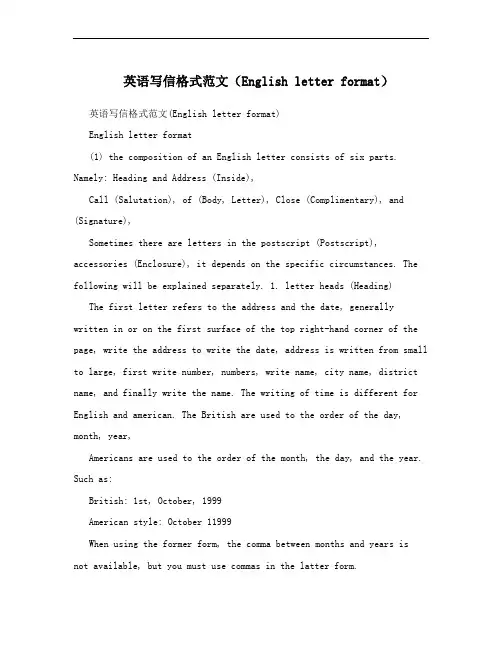
英语写信格式范文(English letter format)英语写信格式范文(English letter format)English letter format(1) the composition of an English letter consists of six parts. Namely: Heading and Address (Inside),Call (Salutation), of (Body, Letter), Close (Complimentary), and (Signature),Sometimes there are letters in the postscript (Postscript), accessories (Enclosure), it depends on the specific circumstances. The following will be explained separately. 1. letter heads (Heading) The first letter refers to the address and the date, generallywritten in or on the first surface of the top right-hand corner of the page, write the address to write the date, address is written from small to large, first write number, numbers, write name, city name, district name, and finally write the name. The writing of time is different for English and american. The British are used to the order of the day, month, year,Americans are used to the order of the month, the day, and the year. Such as:British: 1st, October, 1999American style: October 11999When using the former form, the comma between months and years isnot available, but you must use commas in the latter form.The first letter of the writing and indented block. The beginning of each line to the right indent indent type one ortwo letters; block left aligned, as shown below:indented formWang MingDept. of Chemical EngineeringDalian University of TechnologyDalian 116023Liaoning ProvinceP. R. Chinablock formatWang MingDept. of Chemical EngineeringDalian University of TechnologyDalian 116023Liaoning ProvinceP. R. China2. address Address (Inside)Please write the recipient's name and address in the letter address. Familiar letters and official letters should be addressed to unfamiliar friends and relatives, and familiar with friends can be omitted. The letter address is written in the upper left corner of the one or twoline of the date. The first line writes the receiver's name and address, and then writes the address. Geological is indented and divided to write, block two. Such as:indented formThe PresidentOxford UniversityEngland blockJiang Bin64Heping RoadP.R.China3. (Salutation)The appellation is the appellation to the addressee. Within the address of the letter, the one or two line should be written in the top case. Use commas or colons at the end.(1) when you write to a familiar person, you can use Dear or My Dear. In the UK, My Dear is more cordial than Dear, whilein the United States, Dear is more cordial than My Dear.(2) when writing to a married woman you don't know, you can use Ms...... That's what it means"...... Madam".(3) when writing letters to an unfamiliar person, you can use Dear, sir, Dear, Madam, Dear, Sirs, Gentleman and so on. 4 text (Body, of, Letter)The text is the main part of a letter. Usually write on the nextline of the salutation. Also the method can be used to block or indented style. Each is reflected at the beginning of each paragraph of a row and the back row and qi. Indent refers to the first line of each paragraphto indent several letters to the right. Stationery is concise andefficient. At the beginning of a few simple greeting as the subject, in the end to have wishes and honorific.The common first language is..:I have received your letter of July Ist., July 1st, the letter has been received.I, have, the, pleasure, to, tell, you, that...... I'm glad to tell you.......I am very much delighted to receive your letter., very pleased to receive your letter.It, is, my, honor, to, inform, you, that...... It's my pleasure to tell you.......The common end of a story:I, am, looking, forward, to, hearing, from, you, I hope to hear from you soon.Wish best regards. good luck.Thank, you, for, your, help, thank you for your help!Wish, my, best, wishes, for, your, success., wish you success.Wishing you, a, happy, holiday., have a nice holiday!Hoping to hear from you soon. hope to receive your reply as soon as possible. 5 conclusion (Complimentary, Close)The ending is written at the right side of the one or two line after the text. The initial letters are in capitals, the latter letters are in small case, and the last one is funny.The usual concluding remarks are:General informal relations:Yours sincerely,Yours truly,Yours faithfully,Most sincerely,Faithfully yours,Intimate relationship:Love,你的爱,你的深情,与爱,可爱的你,你永远的朋友,上级和长者:谨上,敬上,6署名(签名)在结束语的下方是签名,先手写出,再打出来。
书信格式万能作文模板范文
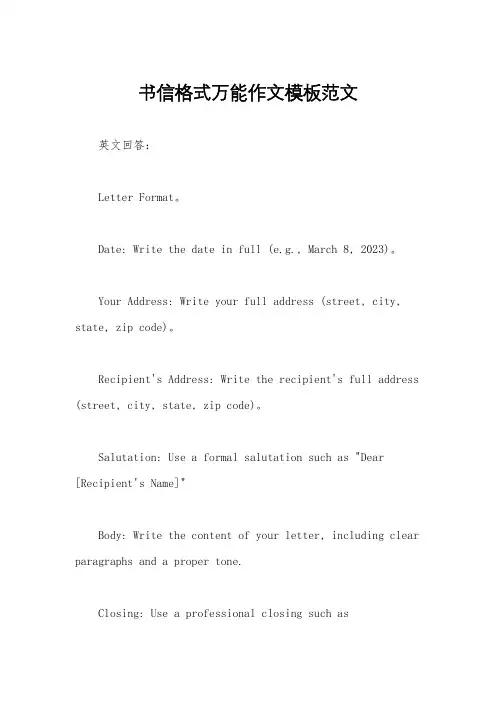
书信格式万能作文模板范文英文回答:Letter Format。
Date: Write the date in full (e.g., March 8, 2023)。
Your Address: Write your full address (street, city, state, zip code)。
Recipient's Address: Write the recipient's full address (street, city, state, zip code)。
Salutation: Use a formal salutation such as "Dear [Recipient's Name]"Body: Write the content of your letter, including clear paragraphs and a proper tone.Closing: Use a professional closing such as"Sincerely," "Regards," or "Best wishes."Signature: Sign your name in ink.Typed Name: Type your typed name below your signature.中文回答:书信格式。
日期,全文写出日期(例如,2023年3月8日)。
发信人地址,写下您的完整地址(街道、城市、州、邮政编码)。
收件人地址,写下收件人的完整地址(街道、城市、州、邮政编码)。
问候语,使用正式问候语,例如“亲爱的 [收件人姓名]”。
正文,写下信的内容,包括清晰的段落和适当的语气。
结尾,使用专业的结束语,例如“此致敬礼”、“此致问候”或“良好祝愿”。
签名,用笔签名。
打印姓名,在您的签名下方输入您的打印姓名。
英语作文书信模板格式
英语作文书信模板格式英文回答:Letter Writing Format Template。
Heading:Include the sender's address and date in the top right corner.Use a standard business letter format, with a left-aligned block style.Salutation:Begin with a formal greeting, such as "Dear [Recipient's Name]."Use a colon after the greeting.Body:Start with an opening paragraph that states the purpose of your letter.Divide the body into paragraphs, each discussing a different aspect of the topic.Use clear and concise language.Provide supporting evidence or examples to back up your claims.Conclusion:Summarize the main points of your letter.State any specific actions or requests you want the recipient to take.End with a formal closing, such as "Sincerely," or "Yours truly."Signature:Leave a space for your handwritten signature.Type your name below the signature line.Example Letter:```。
英语作文各种书信类型格式
英语作文各种书信类型格式Sure, here's a guide to various types of letter formats in English:1. Formal Letter Format:Sender's Address 。
City, State, ZIP Code 。
Date 。
Recipient's Address 。
City, State, ZIP Code 。
Dear [Recipient's Name],。
Subject: [Subject of the Letter]Body of the letter: 。
[Content of the letter, usually divided into paragraphs] Closing: 。
Sincerely, 。
[Your Name]2. Informal Letter Format:Your Address 。
City, State, ZIP Code 。
Date 。
Recipient's Address 。
City, State, ZIP Code 。
Dear [Recipient's Name],。
[Opening greeting]Body of the letter: 。
[Content of the letter, more casual in tone] Closing: 。
Best regards, 。
[Your Name]3. Business Letter Format:Sender's Name 。
Title 。
Company Name 。
Address 。
City, State, ZIP Code 。
Email Address 。
Phone Number 。
Date 。
Recipient's Name 。
Title 。
Company Name 。
LetterFormat书信格式
标点符号
总结词
标点符号是书信格式中不可或缺的元素,它 们用于表示句子的语气、结构和意义。
详细描述
在书信中,应该正确使用标点符号,如逗号 、句号、感叹号和问号等。此外,书信中还 需要注意引号、括号和破折号等符号的使用 。在使用标点符号时,应该遵循语法规则和 习惯用法,以确保书信的准确性和可读性。
03
求职信
在求职过程中,求职信是向潜在雇主展示个人技能、 经验和职业目标的重要工具。书信格式要求清晰、简 洁地表达个人能力和求职意愿,同时注意礼貌用语和 适当的语气。
个人简历
个人简历是求职过程中必不可少的文件,用于向雇主介 绍个人的教育背景、工作经历、技能和成就。书信格式 要求简历内容条理清晰、重点突出,以便雇主快速了解 个人情况。
• 社交书信是用于亲友之间交流感情、分享生活的重要工具。 书信格式要求语言亲切、自然,内容表达真实、感人,同 时注意尊重对方的感受和隐私。
THANKS
感谢观看
在正式的书信中,日期通常会出现在 信纸的中央位置,并且使用特殊的字 体和格式。
日期通常使用较大的字体,并且与签 名保持一定的距离,以便于阅读和辨 别。
收件人姓名和地址
收件人姓名和地址位于信纸的左 上角,包括收件人的全名、地址
和联系信息。
收件人姓名和地址通常使用较小 的字体,并且与信头保持一定的
距离,以避免混淆。
签名
签名是书信的结尾部分,应该包括自 己的全名和职务等信息。
签名应该使用较大的字体,并且与正 文保持一定的距离,以便于阅读和辨 认。
02
书信格式的规范要求
字体和字号
总结词
字体和字号是书信格式中非常重要的元素,它们决定了书信的整体风格和阅读体验。
书信体格式英文作文
书信体格式英文作文The art of letter writing has long been a cherished form of communication, allowing individuals to express their thoughts, feelings, and experiences in a personal and intimate manner. In today's digital age, where electronic communication has become the norm, the traditional letter format remains a powerful and meaningful way to connect with others. Whether you are writing a formal business letter, a heartfelt personal letter, or a letter of recommendation, understanding the proper letter format is crucial for conveying your message effectively.The standard letter format typically consists of several key elements, each serving a specific purpose in the overall structure of the document. The first element is the sender's address, which is typically placed at the top of the letter, either on the right or left side. This information should include the full name, street address, city, state, and zip code of the individual or organization sending the letter.Next, the date should be included, typically two to four lines below the sender's address. The date should be written in a standardizedformat, such as month, day, and year (e.g., March 15, 2023). This information helps the recipient to contextualize the letter and understand when it was written.The third element is the recipient's address, which should be placed several lines below the date. This information should include the full name, title (if applicable), organization, street address, city, state, and zip code of the individual or organization to whom the letter is being sent.The salutation is the next important component of the letter format. This is the greeting that addresses the recipient directly, such as "Dear [Recipient's Name]:" or "To Whom It May Concern:". The choice of salutation should be appropriate for the tone and purpose of the letter, and it should be followed by a colon.The body of the letter is the main content, where the writer conveys their message. This section should be well-organized, with clear and concise language that effectively communicates the purpose of the letter. Paragraphs should be used to separate different ideas or topics, and the overall structure should flow logically from one point to the next.The closing of the letter is the final element, and it should be selected carefully to reflect the tone and purpose of thecommunication. Common closings include "Sincerely," "Best regards," or "Respectfully yours," followed by a comma. The writer's full name should then be typed or printed several lines below the closing.In addition to these standard elements, there are several other considerations to keep in mind when crafting a professional letter. The use of appropriate font size and style, as well as proper spacing and alignment, can all contribute to the overall appearance and readability of the document. Additionally, proofreading the letter for any spelling, grammar, or punctuation errors is essential to ensure a polished and professional final product.One of the key advantages of the letter format is its versatility. Letters can be used for a wide range of purposes, from formal business communications to personal expressions of gratitude or condolence. The structure and tone of the letter can be tailored to the specific needs of the situation, allowing the writer to convey their message in a clear and effective manner.For example, a business letter might be used to propose a new partnership, request a meeting, or provide an update on a project. In this context, the letter format would typically be more formal, with a focus on clear and concise language that conveys the writer's professionalism and expertise. On the other hand, a personal lettermight be used to express condolences, share exciting news, or reconnect with a long-lost friend. In this case, the letter format would be more informal, with a focus on emotional expression and personal connection.Regardless of the purpose, the letter format remains a powerful tool for effective communication. By mastering the elements of a well-crafted letter, writers can ensure that their message is delivered with clarity, professionalism, and impact. Whether you are writing a formal business letter or a heartfelt personal missive, the letter format provides a structured and time-honored framework for conveying your thoughts and ideas to the world.。
- 1、下载文档前请自行甄别文档内容的完整性,平台不提供额外的编辑、内容补充、找答案等附加服务。
- 2、"仅部分预览"的文档,不可在线预览部分如存在完整性等问题,可反馈申请退款(可完整预览的文档不适用该条件!)。
- 3、如文档侵犯您的权益,请联系客服反馈,我们会尽快为您处理(人工客服工作时间:9:00-18:30)。
1)
Hongxin’s Department Store
4507 Shanghai Road, Nanjing, Jiangsu 210047 2) June 7, 2003
3) Ketchum Collection Agency 1267 Hollywood Boulevard Los Angeles, California 91404 U.S.A. 4) ATTENTION: Mr. Terry Roberts
9) company signature 公司签章 It should be used when the signer of the letter is written as a spokesperson for the company, not as an individual. It is often omitted from less formal correspondence.
e.g. “Dear Sir (Madam)” or “Gentlemen”
The trend today is towards informality, especially if the receiver is known to the writer personally.
e.g. “Dear Mr. Mason”
Hongxin’s Department Store
4507 Shanghai Road, Nanjing, Jiangsu 210047 June 7, 2003 Ketchum Collection Agency 1267 Hollywood Boulevard Los Angeles, California 91404 U.S.A. ATTENTION: Mr. Terry Roberts Gentlemen and Ladies, Subject: Mr. Gary Daniels, Account # 69 112 003 We would like to turn over to your services the account of Mr. Gray Daniels, … Sincerely yours, Hongxin’s Department Store
Attention: Mr. Smith Attention The Sales Manager
5) salutation 尊称 It is the polite greeting with which a letter begins. Its form depends upon the writer’s relationship with the receiver.
We are confident that we can reply o Ketchum as we have in the past. Please let us know if there is any further information with which we can furnish you. 8) Sincerely yours, 9) Hongxin’s Department Store
2.2 Parts of a Business Letter
1) letterhead 信头(Standard Parts) It includes the essential particulars about the writer. The printed letterhead is usually centered or at the left margin. e.g. Hongxin’s Department Store 4507 Shanghai Road, Nanjing, Jiangsu 210047
3) inside name and address 封内名址 The name and address of the receiver is typed at the left-hand margin at least two lines below the date. It appears exactly the same way as on the envelope.
10) Mary Zhang Credit Manager
11) MZ / wg 12) Enclosure As stated
13) cc Mr. Norman Hyman
2.3 Letter Styles
1) full-blocked 完全齐头式 All parts begin at the left margin. It is the fastest traditional arrangement style to type.
Unit 2 Letter Format
书信格式
2.1 Letter Appearance
1) typing: single-spaced with doublespacing between paragraphs; clear and dark print; no errors. 2) paragraphing: paragraph breaks come at logical points and result in an even appearance. 3) white space: centering the body of the letter on the page. An ample margin of white space should surround the message.
Байду номын сангаас
2) date 日期 It should be typed three-line-spacing below the letterhead in full and not abbreviated. There is growing tendency to omit the –th, -st, -nd and –rd that follow the day. Avoid giving the dates in figures. e.g. 8 June, 2003 or June 8, 2003
Mary Zhang Credit Manager
MZ / wg Enclosure
cc Mr. Norman Hyman
2) blocked 齐头式 All parts begin at the left margin, except the dateline, complimentary closing, company signature and writer’s identification, which start at the horizontal center of the page.
13) carbon copy 抄送 If you distribute copies of the letter to other readers, type c.c., cc or Cc one or two lines below any enclosure notation.
e.g. Cc Mr. Wright cc Robert Keats, President Jim Carter, Marketing Manager
e.g. Subject: Mr. Gary Daniels, Account #69 112 003
7) body 正文 It contains the actual message of the letter, with the first paragraph referring to any previous correspondence and the last paragraph to future actions or plans.
6) subject line 事由行 It is often inserted between the salutation and the body of a letter to call attention to the topic of the letter. It is also useful as a guide for filing, usually underscored.
e.g.
Ketchum Collection Agency 1267 Hollywood Boulevard Los Angeles, California 91404 U.S.A.
4) attention line 经办人(Optional Parts) It is used when the writer of a letter addressed to an organization wishes to direct it to a particular official or the special person who is in charge of the business. It is typed two line-spacing above the salutation, underscored and except with the full-blocked style, centered over the body of the letter. e.g. For the attention of Mr. Smith
e.g. Mary Zhang Credit Manager
11) reference initials 姓名首字母 It consists of the signer’s initials in capitals followed by a slash or colon followed by the lowercase initials of the person preparing the letter.
